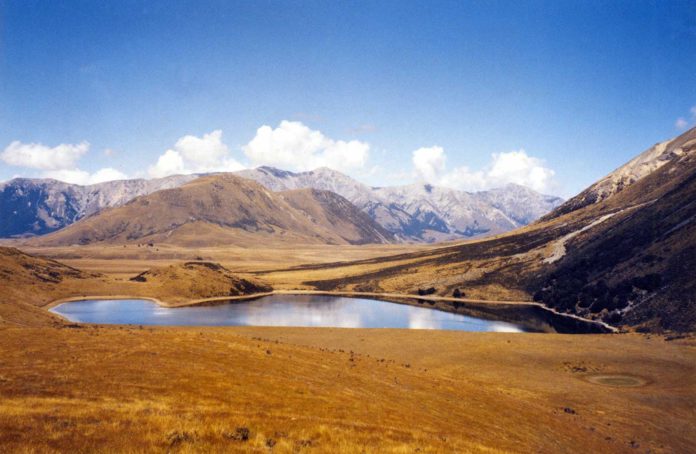Lake Marymere, an oversized high country tarn set amongst tussocks in the Waimakariri River watershed. Photo, Peter Langlands.
Lake Marymere Trout Fishing
By Peter Langlands
Lake Marymere is the only water in New Zealand to support a recognisable strain of Loch Leven trout. The lake was the last catch and release only stillwater in Canterbury. Marymere is situated on a tussock clad plateau, elevated above its neighbour and renowned trophy trout water, Lake Hawdon. Both lakes glimmer like jewels when viewed from the easily climbed surrounding mountain tops. A steep mountainside climbs from the lake’s western shoreline to a considerable height.
The mountain has the remnants of a beech forest on it, whereas the rest of the hillside is of matagouri shrub and rock screes, which hang precariously above the lake. Golden tussocks surround the lake. Unlike Lake Hawdon, Lake Marymere does not have an out flowing stream and the lake is more of an oversized tarn.
Large craggy boulders can be seen under the surface in which dragonfly nymphs thrive. The beech forest and matagouri shrub have green beetles falling off the foliage into the lake’s waters over the summer. The grey stony shoreline is an ideal habitat for dragonfly nymphs, which thrive in the crevices of the large rocks. The lake, therefore, has a bountiful food supply for its trout during the summer.
Fragile fishery
Despite the fishery’s small size, it has now survived for 80 years from natural breeding and is a self-sustaining fishery, which is just as well given the Fish and Game Council’s overall policy of not actively stocking fisheries in the Canterbury region (given that other actions such as habitat protection are perceived as being priorities).
The size of the spawning stock in Lake Marymere is small, possibly as low as several dozen fish, and the fishery is dominated by older fish. Most of the spawning trout in the lake use the shingle on the lake’s southeastern shoreline.
The trout may find spawning difficult when the lake is low, with the spawning shingles exposed. Yet, despite its small size, the lake’s trout population seems to be holding its own. Several other similar stillwater fisheries are found in the South lsland and have survived by the mere fact of their isolation.
Lake Marymere is relatively accessible, being only just over an hour and a half drive from Christchurch. To reach the lake from the shingle Craigieburn Road you will have to park your vehicle and walk about 15 minutes to the lake.
The lake’s distinctive trout are therefore very vulnerable to fishing pressure. Fish and Game made this water a catch and release fishery in 1994 – the region’s first stillwater catch and release fishery. However, this is no longer the case.
Up to 1994, many trout had been kept by people visiting the lake, and many who camped next to the lake over the summer months. Also, people illegally using spinners and bait fishing had taken their toll. The recognition of the water as being catch and release had raised the lake’s profile, and many fly fishermen had pride in that status, and undoubtedly acted as vigilant guardians. We are looking into why that status was changed. We would certainly urge all anglers to continue to practice catch and release at Lake Marymere.
A Challenge
The browns cruise in exceedingly close in Marymere – an unnerving situation for visiting anglers. I say unnerving because the browns average 6 pounds and many 8 pounders can be seen – trophy-sized stillwater trout by South Island standards. Canterbury angler, Mike Gopperth has also caught an eleven pounder out of the lake.
The reality of fishing Marymere is a disappointment for many anglers. The lake is not easy to fish, having watched both my father and brother, with their many years of experience, failing to hook a fish. Only a handful of Christchurch anglers have successfully innovated techniques for fishing Marymere.
The trout are large and accordingly vary.
If you are easily phased by not successfully hooking a trout, then you should not visit Marymere. But over time, perseverance will pay off. The trout you catch may well be a trophy and you can marvel as you slip the trout back into the lake and watch its olive back disappear back into the inky black depths.
Fishing techniques for Lake Marymere
Foam beetles and dark silhouettes. A pattern which proved successful at Lake Marymere is a large black foam beetle pattern fished on low diameter lines such as Deceiver. The Marymere trout are extremely hard to catch and are very wary, therefore good presentation is critical. The steep mountainside on the lake’s western shoreline blocks out the afternoon’s sun, resulting in dark light falling on the lake in the early evening. So fishing a large dry fly with a distinct silhouette has its advantages.
Dragonfly nymphs
Fishing dragonfly nymph patterns are also successful, but the fish can be extremely fickle about taking dragonfly nymphs. l say this after watching my brother spotting a large olive backed brown cruising in the lake’s shallows during a northwest gale. The fish was in such shallow water that its back could be seen projecting out of the water. Nymphs would have undoubtedly been dislodged in the strong wind and washed up along the shoreline. The cruiser’s path was deliberate, possibly seeking out dragonfly nymphs removed from the rocks. A careful presentation was made into the gusty northwester but to no avail. Trying other nymphs resulted in the same response. Such is the challenge of fishing for Marymere’s trophies.
Some final thoughts
Lake Marymere is a summer fishing location. The trout are most active (feeding wise) from mid-December to late February. Fishing at Lake Marymere during a warm summer’s evening with a light nor’wester is a truly magical fishing experience.
Lake Marymere 2021-2022 Season Fishing Regulations
Fishing is permitted from1st Saturday in November to 30 April. Fly fishing only. Limit Bag is 2 trout. Motorised boats are not permitted.
Credit: Source link































